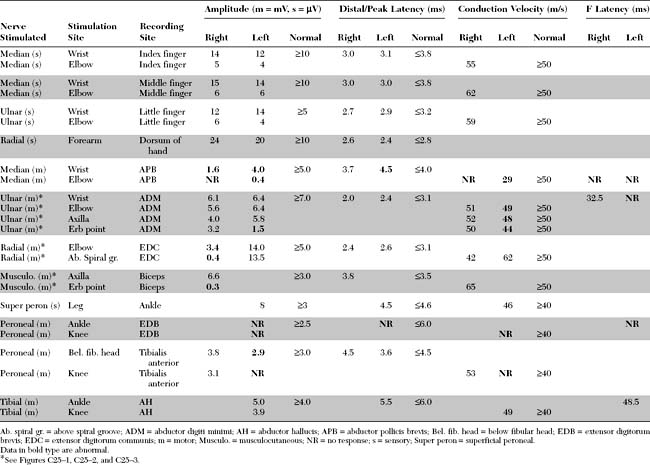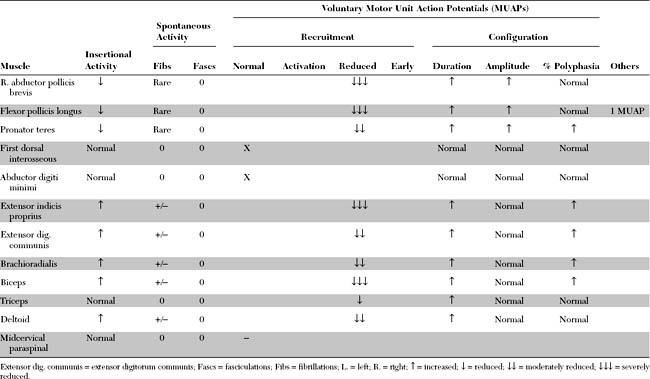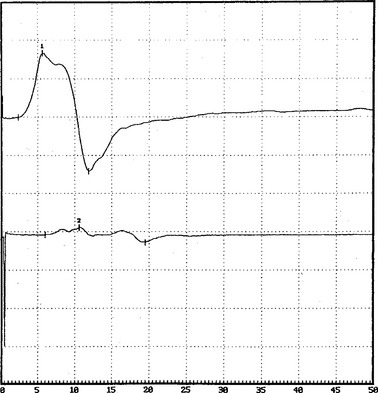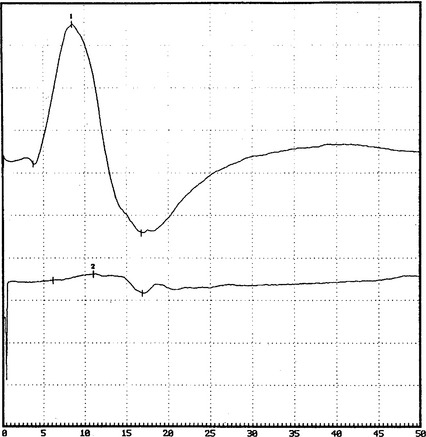Case 25
HISTORY AND PHYSICAL EXAMINATION
| Right | Left | |
|---|---|---|
| Shoulder abduction | 2/5 | 5/5 |
| Elbow flexion | 3/5 | 5/5 |
| Elbow extension | 4−/5 | 5/5 |
| Pronation | 0/5 | 3/5 |
| Fingers flexion | 0/5 | 3/5 |
| Wrist flexion | 1/5 | 1/5 |
| Wrist extension | 2/5 | 5/5 |
| Finger extension | 3/5 | 4−/5 |
| Finger abduction | 4−/5 | 3/5 |
| Right | Left | |
|---|---|---|
| Hip flexion | 5/5 | 5/5 |
| Hip extension | 5/5 | 5/5 |
| Knee extension | 5/5 | 5/5 |
| Knee flexion | 5/5 | 5/5 |
| Foot dorsiflexion | 5/5 | 1/5 |
| Toe dorsiflexion | 5/5 | 0/5 |
| Plantar flexion | 5/5 | 5/5 |
| Ankle inversion | 5/5 | 5/5 |
| Ankle eversion | 5/5 | 1/5 |
Please now review the Nerve Conduction Studies and Needle EMG tables.
QUESTIONS
1. Based on clinical grounds, the differential diagnosis should include all of the following except:
EDX FINDINGS AND INTERPRETATION OF DATA
Relevant EDX findings in this case include:
1. Normal sensory nerve action potentials (SNAPs) amplitudes, distal latencies, and conduction velocities throughout.
2. Multifocal conduction blocks, some partial and others near complete. The motor nerves with conduction blocks are the following:
3. Severe impairment of recruitment with scattered fibrillation potentials and increased motor unit action potential (MUAP) duration and polyphasia in muscles that follow multiple peripheral nerve distribution; this correlates anatomically with the sites of conduction block.
DISCUSSION
Definition and Pathogenesis
Multifocal motor neuropathy (MMN), described in the mid-1980s, is a rare disorder with a prevalence of 1 to 2 individuals per 100 000. It is characterized by specific EDX finding, i.e., motor conduction blocks, which is the gold standard for diagnosis. The disorder is important to recognize since it is treatable and responsive to immunomodulating therapies, and may mimic amyotrophic lateral sclerosis (ALS) which has a poor prognosis for survival.












